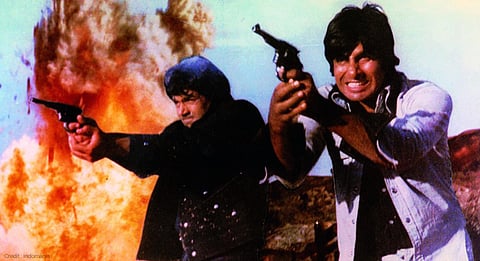
- Reviews
- Power List 2024
- Cannes 2024
- In-Depth Stories
- Web Stories
- News
- FC Lists
- Interviews
- Features
- FC SpecialsFC Specials

On March 21st, an HD remastered version of Sholay will officially become available to YouTube's 300 million viewers. I'm overjoyed. Because while millennials have an unending fascination for the 1990s, I think they consider 1975 prehistoric. I constantly meet people under-30 who haven't seen Ramesh Sippy's classic. And I resist the urge to lecture, harangue and pummel them into watching it immediately.
For me, Sholay is the gold standard of Hindi cinema. A film that seamlessly blends every ingredient that a traditional Hindi film requires – drama, emotion, action, romance, comedy, songs, stars, an iconic villain and even a memorable item number. Of course, the film derives from the Hollywood Western (which itself took inspiration from Kurosawa's samurai epics) but what we see onscreen is a distinctly desi saga with dakus, a thakur, jean-clad mercenaries and the village belle Basanti. In Salim-Javed's masterful script, modern and old-fashioned elements sit side by side without jarring. Which is why 43 years later, the film doesn't seem dated.
Sholay is my first memory of cinema. I don't remember seeing the film in a theatre but I remember being afraid of the high-pitched screeching soundtrack that played when Gabbar Singh entered the frame. The film changed my life. To commemorate its 25th anniversary, Ramesh Sippy's children – Rohan, Sheena and Sonya – commissioned me to write a book on Sholay. I had never written a book before but I loved the film and decided to give it a shot. I spent almost a year researching and writing. I interviewed everyone from the late Amjad Khan's wife Shaila to Amitabh Bachchan to the late Mac Mohan, who narrated a fascinating story about his character Sambha – he told me that when he saw the final film, he was in tears because his role had been slashed. He asked Ramesh to throw his character out completely because he didn't want to be seen as an extra. Ramesh replied that he couldn't do anything at that stage but added – I will tell you one thing, if this picture runs, nobody will forget Sambha. Ramesh was right – Sambha is perhaps the only character in cinema to immortalized by just three words – Poore pachaas hazaar. Research revealed that the making of the film was as dramatic as the film itself and the book, Sholay: The Making of a Classic (released in 2000), won the National Award for Best Book on Cinema.
Through the process of writing the book, I understood a fundamental truth about the movies – that great films can't be designed. They come from a grand passion and a special kind of madness. A madness that compelled Ramesh Sippy and his crew to create a village in Ramanagaram near Bengaluru for the shoot. The space was a vast emptiness – even the road leading to the set had to be built. Or one that made them shoot two, one-minute sequences of Radha (Jaya Bachchan) extinguishing the lamps while Jai (Amitabh Bachchan) played the harmonica, over twenty days. Because Ramesh and DOP Dwarka Divecha decided that these tender scenes required the golden hue of the magic hour, the few minutes between sunset and night. It took several schedules to get it right.
In 1995, on the 20th anniversary of the film, I did an article for India Today magazine on how the film continued to be Bollywood's most successful re-run product. At the time, around 60 prints were in circulation and the film was running to packed audiences. Which prompted distributor Shyam Shroff to remark: As they used to say about the British empire – the sun never sets on Sholay.
Now with a digital version, this will forever be true. I know that small screens won't do justice to the grandeur of Ramesh Sippy's 70 mm vision. But I'm thrilled that the film will find a new generation of viewers. The magic endures.